A Deep-Learning-Based Bearing Fault Diagnosis Using Defect Signature Wavelet Image Visualization
Abstract
1. Introduction
- (1)
- To alleviate the limitations of previous methods used for transformation of1-D signals into 2-D images, a novel 2-D representation method is created by combining the envelope analysis and continuous wavelet transform (CWT) with filtering by the frequency range covering the bearing defect frequencies to generate the defect signature wavelet image (DSWI). The constructed DSWI is considered as the new signature, which solves the modulation problem, reduces the nonstationary effect in the signal, demonstrates the distinct patterns for the different types of faults in bearings, and closely relates to the defect frequencies in the envelope spectrum.
- (2)
- This study also introduces a specific architecture of the deep convolutional neural network (DCNN) for classifying multiple fault types that occur in bearings by learning the specific features from the DSWI representations. To estimate the performance of the proposed approach, it has been evaluated using the laboratory dataset collected from the bearing testbed. Finally, the results of the proposed method are compared with other methods presented in the literature.
2. Seed to the Data Acquisition System and Experimental Process
3. Fault Diagnosis Methodology Using the Defect Signature Wavelet Image
3.1. Bearing Fault Signature and Wavelet Analysis
3.2. 2-D Data Representation with Defect Signature Wavelet Image Generation
3.3. Deep Convolution Neural Network Structure Specification
4. Methodology Evaluation Results
4.1. Performance Evaluation of DSWI Compared to Vibration Image and Conventional Wavelet Spectrogram
4.2. Performance Comparison with Difference Model for Classification
5. Conclusions
Author Contributions
Funding
Conflicts of Interest
References
- Lau, E.C.C.; Ngan, H.W. Detection of Motor Bearing Outer Raceway Defect by Wavelet Packet Transformed Motor Current Signature Analysis. IEEE Trans. Instrum. Meas. 2010, 59, 2683–2690. [Google Scholar] [CrossRef]
- Nishat Toma, R.; Kim, J.-M. Bearing Fault Classification of Induction Motors Using Discrete Wavelet Transform and Ensemble Machine Learning Algorithms. Appl. Sci. 2020, 10, 5251. [Google Scholar] [CrossRef]
- Gao, Z.; Cecati, C.; Ding, S.X. A Survey of Fault Diagnosis and Fault-Tolerant Techniques—Part I: Fault Diagnosis With Model-Based and Signal-Based Approaches. IEEE Trans. Ind. Electron. 2015, 62, 3757–3767. [Google Scholar] [CrossRef]
- Gao, Z.; Cecati, C.; Ding, S.X. A Survey of Fault Diagnosis and Fault-Tolerant Techniques—Part II: Fault Diagnosis With Knowledge-Based and Hybrid/Active Approaches. IEEE Trans. Ind. Electron. 2015, 62, 3768–3774. [Google Scholar] [CrossRef]
- Prosvirin, A.E.; Piltan, F.; Kim, J.-M. Hybrid Rubbing Fault Identification Using a Deep Learning-Based Observation Technique. IEEE Trans. Neural Netw. Learn. Syst. 2020, 32, 1–12. [Google Scholar] [CrossRef]
- Piltan, F.; Kim, J.-M. Bearing Fault Diagnosis Using an Extended Variable Structure Feedback Linearization Observer. Sensors 2018, 18, 4359. [Google Scholar] [CrossRef] [PubMed]
- Piltan, F.; Prosvirin, A.E.; Jeong, I.; Im, K.; Kim, J.-M. Rolling-Element Bearing Fault Diagnosis Using Advanced Machine Learning-Based Observer. Appl. Sci. 2019, 9, 5404. [Google Scholar] [CrossRef]
- Kang, M.; Kim, J.; Wills, L.M.; Kim, J.-M. Time-Varying and Multiresolution Envelope Analysis and Discriminative Feature Analysis for Bearing Fault Diagnosis. IEEE Trans. Ind. Electron. 2015, 62, 7749–7761. [Google Scholar] [CrossRef]
- Manjurul Islam, M.M.; Kim, J.-M. Reliable multiple combined fault diagnosis of bearings using heterogeneous feature models and multiclass support vector Machines. Reliab. Eng. Syst. Saf. 2019, 184, 55–66. [Google Scholar] [CrossRef]
- Do, V.T.; Chong, U.-P. Signal Model-Based Fault Detection and Diagnosis for Induction Motors Using Features of Vibration Signal in Two- Dimension Domain. J. Mech. Eng. 2011, 57, 655–666. [Google Scholar] [CrossRef]
- Wen, L.; Li, X.; Gao, L.; Zhang, Y. A New Convolutional Neural Network-Based Data-Driven Fault Diagnosis Method. IEEE Trans. Ind. Electron. 2018, 65, 5990–5998. [Google Scholar] [CrossRef]
- Tra, V.; Khan, S.A.; Kim, J.-M. Diagnosis of bearing defects under variable speed conditions using energy distribution maps of acoustic emission spectra and convolutional neural networks. J. Acoust. Soc. Am. 2018, 144, EL322–EL327. [Google Scholar] [CrossRef] [PubMed]
- Sohaib, M.; Kim, J.-M. Fault Diagnosis of Rotary Machine Bearings under Inconsistent Working Conditions. IEEE Trans. Instrum. Meas. 2020, 69, 3334–3347. [Google Scholar] [CrossRef]
- Hasan, M.J.; Kim, J.-M. Bearing Fault Diagnosis under Variable Rotational Speeds Using Stockwell Transform-Based Vibration Imaging and Transfer Learning. Appl. Sci. 2018, 8, 2357. [Google Scholar] [CrossRef]
- Cai, J.; Xiao, Y. Time-frequency analysis method of bearing fault diagnosis based on the generalized S transformation. J. Vibroeng. 2017, 19, 4221–4230. [Google Scholar] [CrossRef]
- Pham, M.T.; Kim, J.-M.; Kim, C.H. Accurate Bearing Fault Diagnosis under Variable Shaft Speed using Convolutional Neural Networks and Vibration Spectrogram. Appl. Sci. 2020, 10, 6385. [Google Scholar] [CrossRef]
- Huang, W.; Gao, G.; Li, N.; Jiang, X.; Zhu, Z. Time-Frequency Squeezing and Generalized Demodulation Combined for Variable Speed Bearing Fault Diagnosis. IEEE Trans. Instrum. Meas. 2019, 68, 2819–2829. [Google Scholar] [CrossRef]
- Tse, P.W.; Yang, W.; Tam, H.Y. Machine fault diagnosis through an effective exact wavelet analysis. J. Sound Vib. 2004, 277, 1005–1024. [Google Scholar] [CrossRef]
- Bessous, N.; Zouzou, S.E.; Bentrah, W.; Sbaa, S.; Sahraoui, M. Diagnosis of bearing defects in induction motors using discrete wavelet transform. Int. J. Syst. Assur. Eng. Manag. 2018, 9, 335–343. [Google Scholar] [CrossRef]
- Zhang, X.; Liu, Z.; Wang, J.; Wang, J. Time–frequency analysis for bearing fault diagnosis using multiple Q-factor Gabor wavelets. ISA Trans. 2019, 87, 225–234. [Google Scholar] [CrossRef]
- Randall, R.B.; Antoni, J. Rolling element bearing diagnostics—A tutorial. Mech. Syst. Signal Process. 2011, 25, 485–520. [Google Scholar] [CrossRef]
- Ben Ali, J.; Fnaiech, N.; Saidi, L.; Chebel-Morello, B.; Fnaiech, F. Application of empirical mode decomposition and artificial neural network for automatic bearing fault diagnosis based on vibration signals. Appl. Acoust. 2015, 89, 16–27. [Google Scholar] [CrossRef]
- Janssens, O.; Slavkovikj, V.; Vervisch, B.; Stockman, K.; Loccufier, M.; Verstockt, S.; Van de Walle, R.; Van Hoecke, S. Convolutional Neural Network Based Fault Detection for Rotating Machinery. J. Sound Vib. 2016, 377, 331–345. [Google Scholar] [CrossRef]
- Duong, B.P.; Kim, J.-M. Non-Mutually Exclusive Deep Neural Network Classifier for Combined Modes of Bearing Fault Diagnosis. Sensors 2018, 18, 1129. [Google Scholar] [CrossRef] [PubMed]
- R15I-AST—150 kHz Integral Preamp AE Sensor. Available online: https://www.physicalacoustics.com/by-product/sensors/R15I-AST-150-kHz-Integral-Preamp-AE-Sensor (accessed on 18 October 2020).
- PCB Model 622B01. Available online: https://www.pcb.com/products?model=622B01&item_id=Products&m=052BR030BZ (accessed on 18 October 2020).
- Wang, D.; Miao, Q.; Fan, X.; Huang, H.-Z. Rolling element bearing fault detection using an improved combination of Hilbert and wavelet transforms. J. Mech. Sci. Technol. 2009, 23, 3292–3301. [Google Scholar] [CrossRef]
- Kang, M.; Kim, J.; Kim, J.-M. High-Performance and Energy-Efficient Fault Diagnosis Using Effective Envelope Analysis and Denoising on a General-Purpose Graphics Processing Unit. IEEE Trans. Power Electron. 2015, 30, 2763–2776. [Google Scholar] [CrossRef]
- LeCun, Y.; Boser, B.; Denker, J.S.; Henderson, D.; Howard, R.E.; Hubbard, W.; Jackel, L.D. Backpropagation Applied to Handwritten Zip Code Recognition. Neural Comput. 1989, 1, 541–551. [Google Scholar] [CrossRef]
- Krizhevsky, A.; Sutskever, I.; Hinton, G.E. ImageNet classification with deep convolutional neural networks. Commun. ACM 2017, 60, 84–90. [Google Scholar] [CrossRef]
- Ojala, T.; Pietikainen, M.; Maenpaa, T. Multiresolution gray-scale and rotation invariant texture classification with local binary patterns. IEEE Trans. Pattern Anal. Mach. Intell. 2002, 24, 971–987. [Google Scholar] [CrossRef]
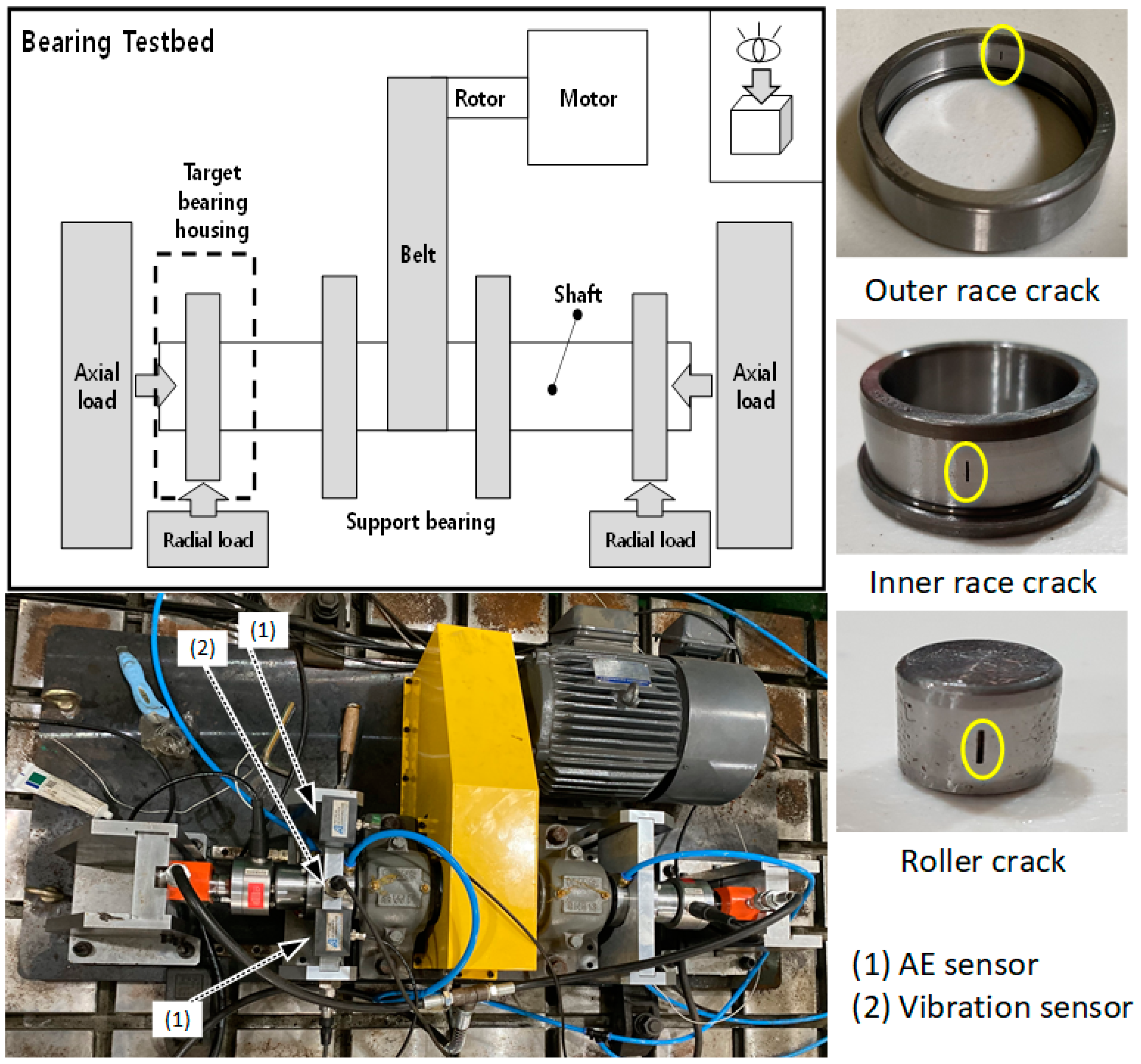
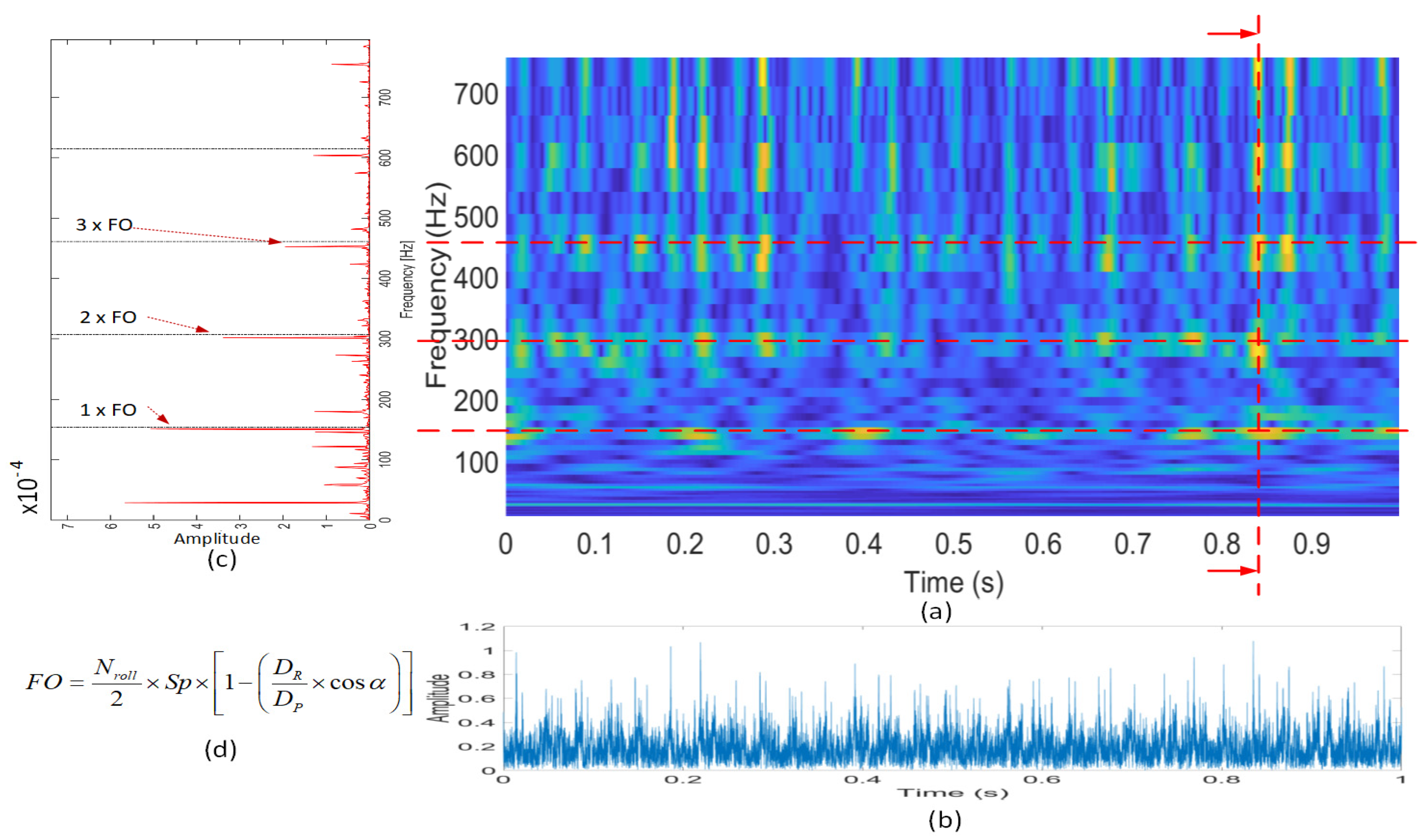
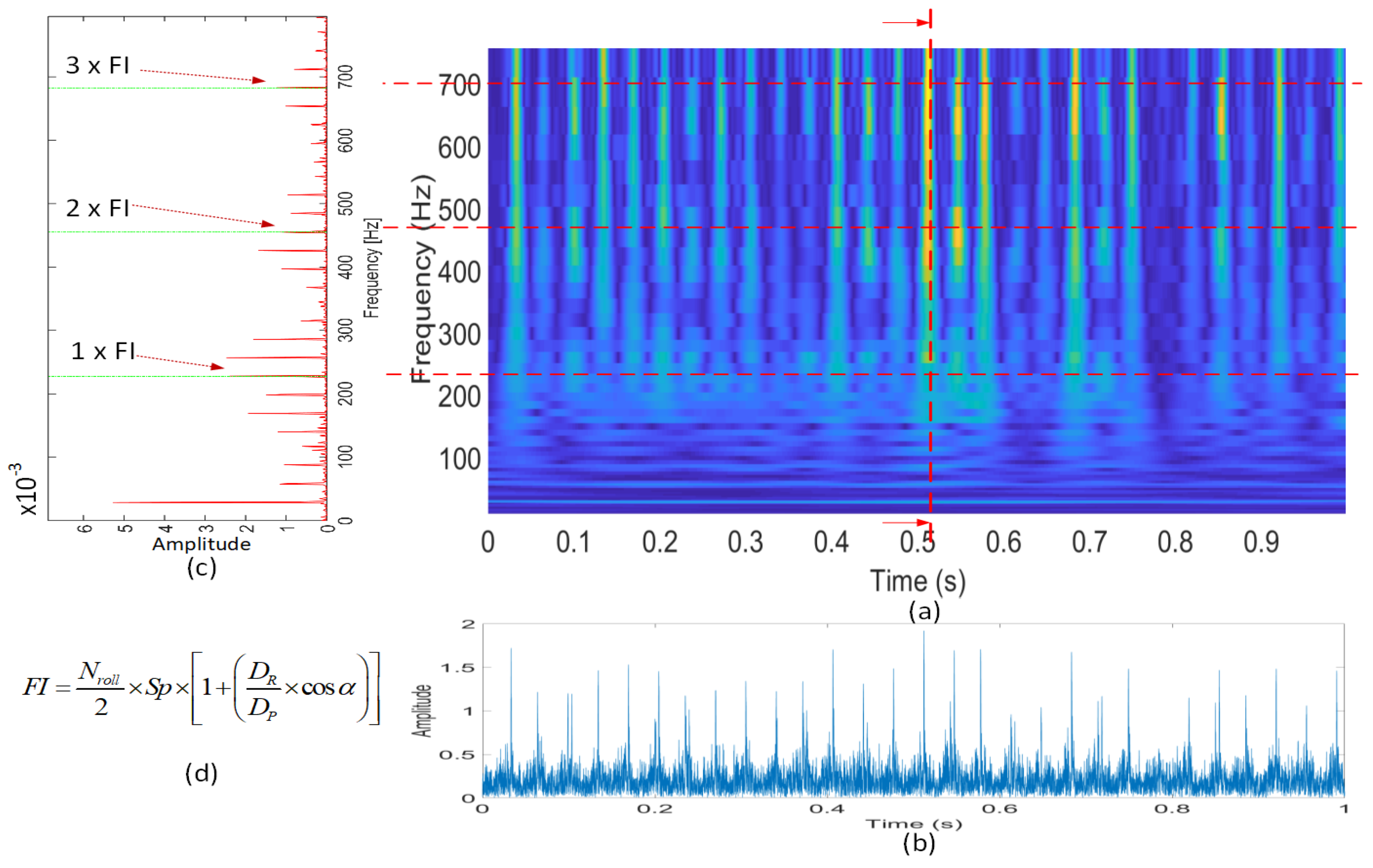
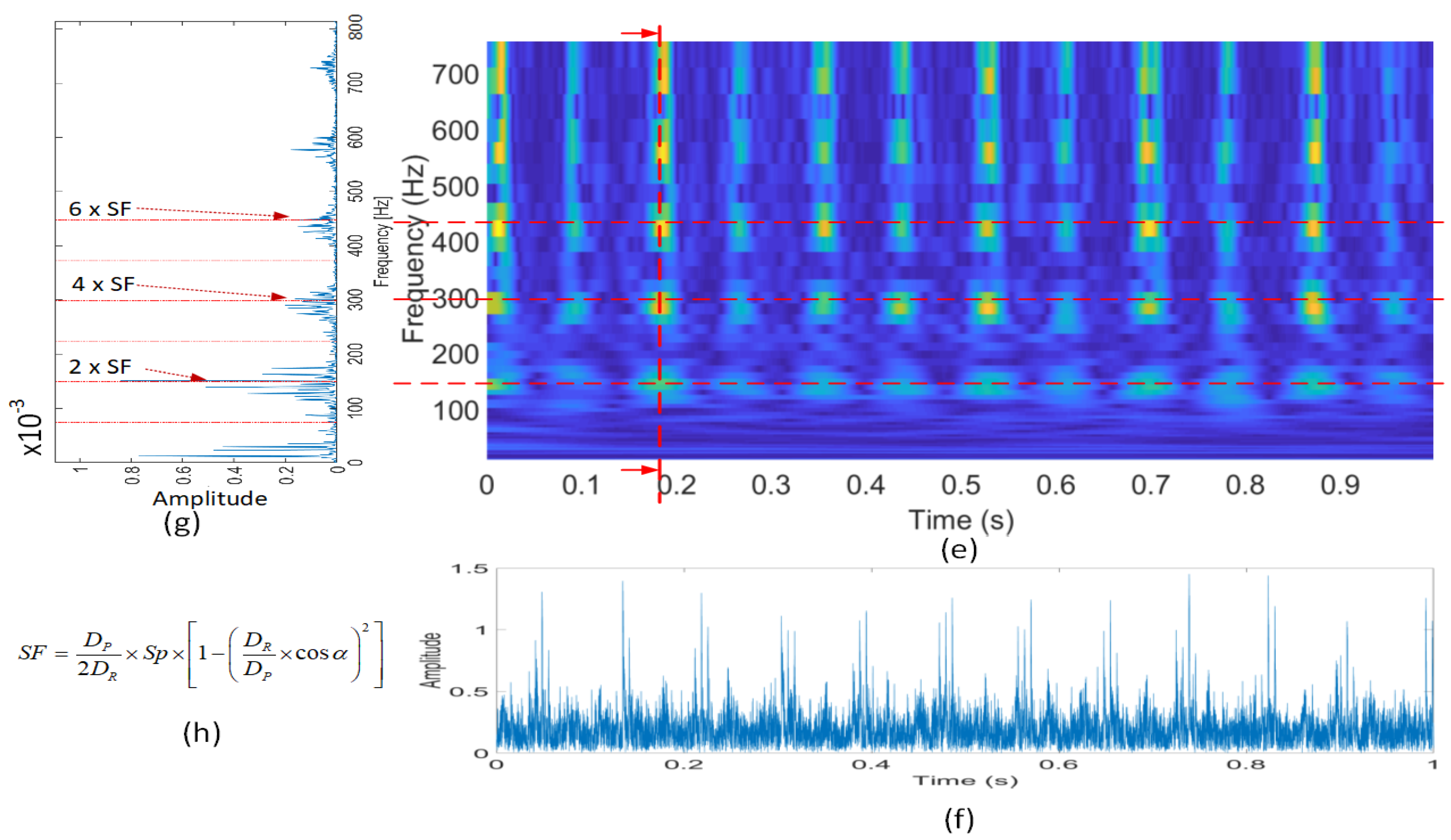
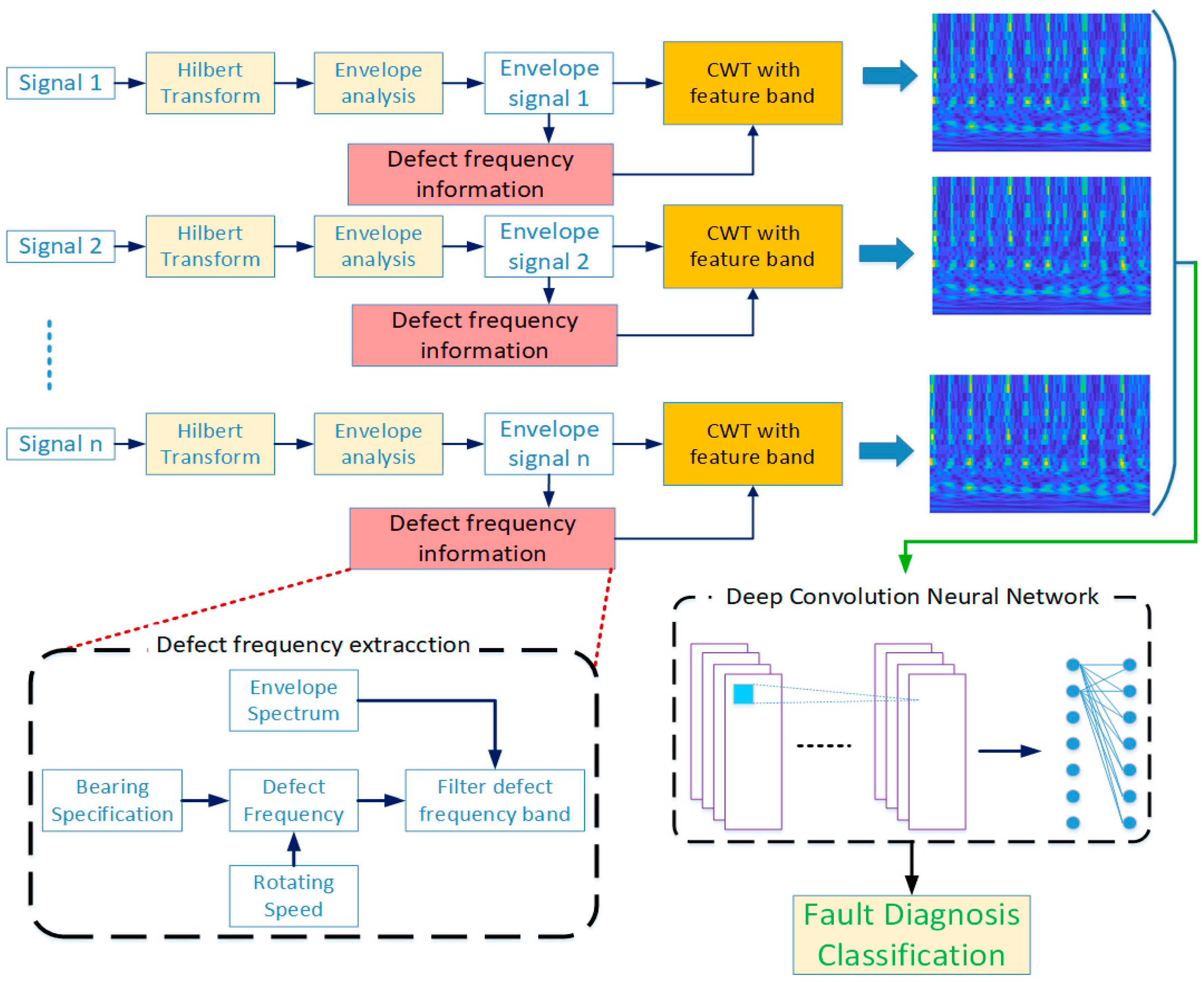

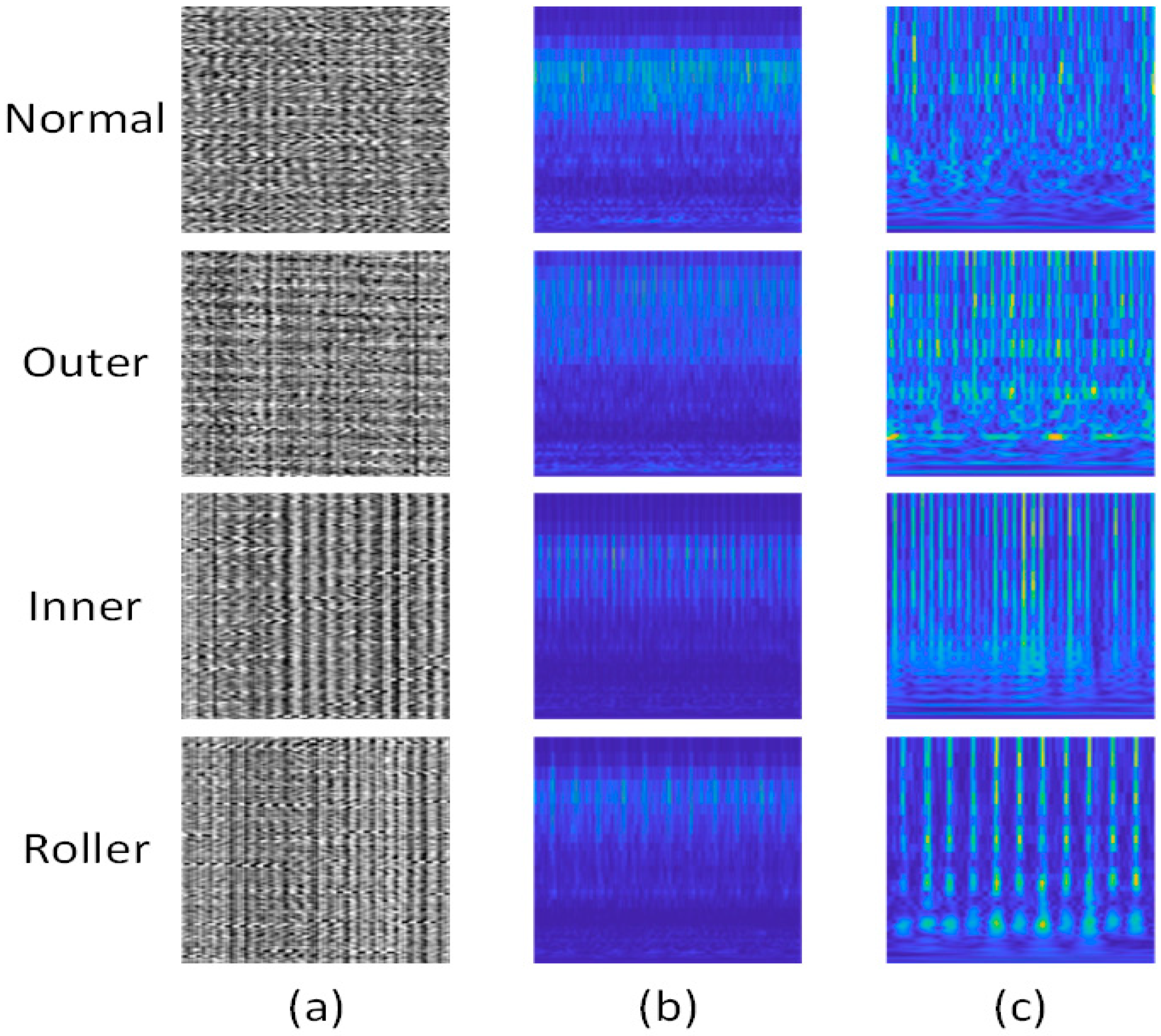
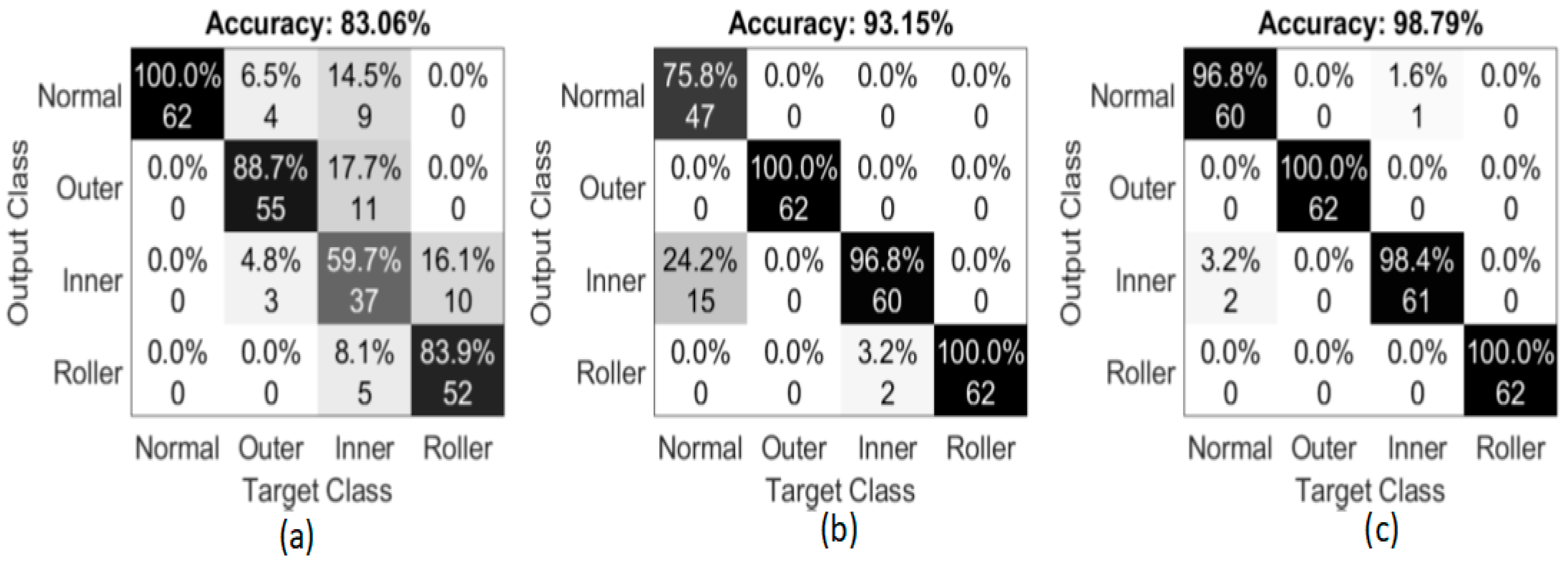
| Devices | Detailed Specification |
|---|---|
| AE sensor R15I-AST |
|
| Vibration sensor PCB-622B01 |
|
| DAQ type NI 9234 |
|
| Scenarios | Type | Vibration Image Method | Wavelet Spectrogram | DSWI |
|---|---|---|---|---|
| (1) KNN + PCA | Normal | 35.50% | 0% | 93.50% |
| Outer | 41.90% | 100% | 88.70% | |
| Inner | 30.60% | 45.20% | 61.30% | |
| Roller | 98.40% | 50.00% | 0% | |
| Average accuracy | 51.42% | 48.99% | 61.13% | |
| (2) MCSVM + PCA | Normal | 100% | 75.20% | 85.20% |
| Outer | 96.80% | 84.23% | 90.02% | |
| Inner | 91.90% | 86.80% | 86.70% | |
| Roller | 35.50% | 81.40% | 89.12% | |
| Average accuracy | 80.97% | 81.91% | 87.76% | |
| (3) LeNet-5 | Normal | 32.25% | 96.77% | 93.54% |
| Outer | 65.00% | 100% | 96.77% | |
| Inner | 35.00% | 59.67% | 93.54% | |
| Roller | 60.00% | 100% | 100% | |
| Average accuracy | 46.77% | 89.11% | 95.97% | |
| (4) AlexNet | Normal | 64.52% | 64.51% | 98.38% |
| Outer | 100% | 100% | 100% | |
| Inner | 13.33% | 98.38% | 93.54% | |
| Roller | 96.77% | 100% | 100% | |
| Average accuracy | 68.54% | 90.72% | 97.98% | |
| Proposed DCNN | Normal | 100% | 75.80% | 96.80% |
| Outer | 88.70% | 100% | 100% | |
| Inner | 59.70% | 96.80% | 98.40% | |
| Roller | 83.90% | 100% | 100% | |
| Average accuracy | 83.06% | 93.15% | 98.79% |
Publisher’s Note: MDPI stays neutral with regard to jurisdictional claims in published maps and institutional affiliations. |
© 2020 by the authors. Licensee MDPI, Basel, Switzerland. This article is an open access article distributed under the terms and conditions of the Creative Commons Attribution (CC BY) license (http://creativecommons.org/licenses/by/4.0/).
Share and Cite
Duong, B.P.; Kim, J.Y.; Jeong, I.; Im, K.; Kim, C.H.; Kim, J.M. A Deep-Learning-Based Bearing Fault Diagnosis Using Defect Signature Wavelet Image Visualization. Appl. Sci. 2020, 10, 8800. https://doi.org/10.3390/app10248800
Duong BP, Kim JY, Jeong I, Im K, Kim CH, Kim JM. A Deep-Learning-Based Bearing Fault Diagnosis Using Defect Signature Wavelet Image Visualization. Applied Sciences. 2020; 10(24):8800. https://doi.org/10.3390/app10248800
Chicago/Turabian StyleDuong, Bach Phi, Jae Young Kim, Inkyu Jeong, Kichang Im, Cheol Hong Kim, and Jong Myon Kim. 2020. "A Deep-Learning-Based Bearing Fault Diagnosis Using Defect Signature Wavelet Image Visualization" Applied Sciences 10, no. 24: 8800. https://doi.org/10.3390/app10248800
APA StyleDuong, B. P., Kim, J. Y., Jeong, I., Im, K., Kim, C. H., & Kim, J. M. (2020). A Deep-Learning-Based Bearing Fault Diagnosis Using Defect Signature Wavelet Image Visualization. Applied Sciences, 10(24), 8800. https://doi.org/10.3390/app10248800








